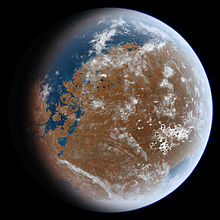From Wikipedia, the free encyclopedia

An artist's impression of what ancient Mars may have looked like, based on geological data
Dry channels near Warrego Valles
There are no bodies of liquid water on the Martian surface because its atmospheric pressure at the surface averages 600 pascals (0.087 psi) —about 0.6% of Earth's mean sea level pressure— and because the temperature is far too low, (210 K (−63 °C)) leading to immediate freezing. Despite this, about 3.8 billion years ago,[4] there was a denser atmosphere, higher temperature, and vast amounts of liquid water flowed on the surface,[5][6] including large oceans.[7][8][9][10][11] It has been estimated that the primordial oceans on Mars would have covered between 36% [12][13] and 75% of the planet.[14]
There are a number of direct and indirect proofs of water presence either on or under the surface, e.g. dry stream beds,[15][16][17][18] polar caps, glaciers,[19][20][21][22][23] radar and spectroscopic measurements,[24] eroded craters and weathered minerals directly connected to the past existence of liquid water.[25][26][27][28][29] Several Mars orbiters have detected the basins of ancient lakes,[30][31][32][33][34][35][36] ancient river valleys,[16][37] and evidence of widespread glaciations,[20][38][39][40][41] while several landers and rovers directly analyzed soil and water ice from the shallow sub-surface.
Although the surface of Mars was wet and could have been hospitable to microbial life billions of years ago,[42] the present damaging effect of ionising radiation on cellular structure is one of the prime limiting factors on the survival of life on the surface.[43][44] Therefore, the best potential locations for discovering life on Mars may be at subsurface environments.[45][46][47]
No comments:
Post a Comment